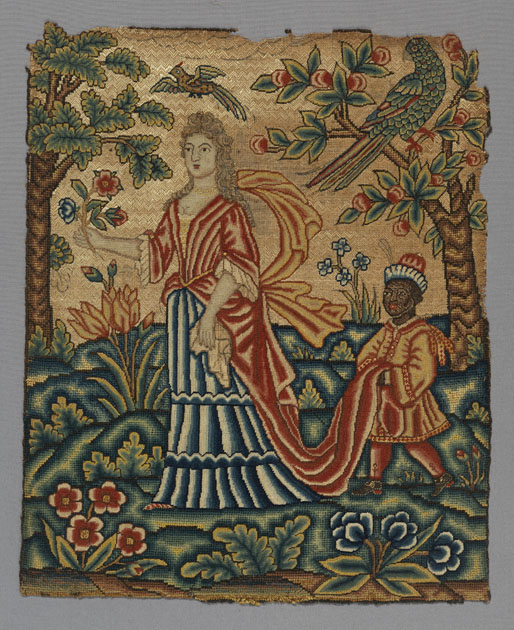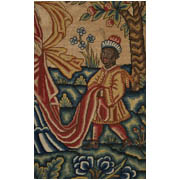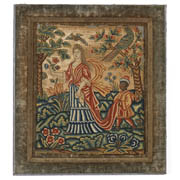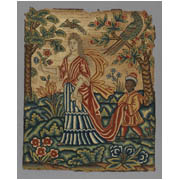Details
- Object type
embroidered panel; needlework panel
- Place Associated
Britain (place of manufacture)
- Date
circa 1700-1715
- Materials
linen, wool, silk
- Dimensions
framed: 628 mm x 562 mm x 48 mm; panel: 393 mm x 323 mm 583 g
- Description
-
Embroidered panel or needlework panel in linen (14 threads per cm) embroidered in light blue, blue, dark blue, light brown, brown, cream, light green, green, red and yellow wool and silk thread worked in tent, half-cross and cross stitch depicting a woman in a red mantua, open bodice with yellow stomacher, skirt tied back to reveal blue petticoat with yellow stole holding a flower, with an enslaved page in red and white hat, yellow coat and red stockings holding her train, set in a stylised landscape with cream zig-zag sky, bird, parrot, trees, flowers, including tulips.
Today the terms embroidery and needlework can be used synonymously, however, during the late 1500s to early 1700s the terms were applied to two different techniques. Embroidery referred to items worked with a variety of predominately surface stitches, such as detached buttonhole and satin, that did not completely cover the ground fabric, which was often a silk satin. Needlework was the term used for linen items that were completely covered with stitches worked mainly in tent or cross stitch.
Although the vast majority of peoples trafficked by slave traders ended up working on plantations in America, the Caribbean and Africa, a small proportion of young African and Asian boys and girls were brought back to Britain by slave traders, merchants and high-ranking naval officers specifically to become domestic servants. Many of these young enslaved children were not hidden below stairs, but openly waited in attendance on their owners acting as pages, maids and grooms, and were dressed accordingly in sumptuous liveries. Whilst no exact print source for this embroidery has been identified yet, several contemporary portraits from the period show the sitter accompanied by an black servant who either holds the lady's train or presents a basket of flowers or fruit. Similarly, a needlework panel now in the collections of Fenton House, London (National Trust NT 1449256) shows a seated lady being served fruit by an enslaved page.
See also Legacies of Slavery - Enslaved Black Boys and Legacies of Slavery – A Fashionable Accessory?
William Burrell framed and hung this needlework panel in the Tower Sitting Room at Hutton Castle, Berwickshire.
Provenance: Lenygon & Morant, London; from whom purchased by Sir William Burrell on 30 January 1930 for £85.
- Credit Line/Donor
Gifted by Sir William and Lady Burrell to the City of Glasgow, 1944
- Collection
Burrell Collection: British Embroideries
- ID Number
29.92
- Location
Burrell Collection





